192: Difference between revisions
No edit summary |
Pbcjohnston (talk | contribs) SEO updates |
||
| (15 intermediate revisions by 2 users not shown) | |||
| Line 1: | Line 1: | ||
{{#seo:|title=USS Squalus (SS-192) - PigBoats.COM|title_mode=replace|keywords=USS Squalus submarine, USS Squalus submarine photos}} | |||
{{#seo:|description=Notes, photographs, and pictures of the U.S. Navy's submarine USS Squalus (SS-192)}} | |||
=== [[File: | [[File:Hew Header Salmon-class.jpg]] | ||
[[File:Red bar sub new.jpg]] | |||
===<big>Notes</big>=== | |||
<div style="text-align: justify;"><span style="color:#00008B">PigBoats.COM has a collection of photos taken during the rescue and salvage operations when Squalus sank during a test dive on May 23, 1939. Those photos can be seen [[Notable Submarine Accidents|'''at this link''']]. For her wartime days in her second identity as Sailfish, please see the page [[192a|'''at this link''']]. | |||
[[File:Red bar sub new.jpg]] | |||
[[File:Squalus build 1.jpg|left|500px]] | |||
<div style="text-align: justify;"><span style="color:#00008B">Squalus under construction at the Portsmouth Navy Yard, Kittery, Maine, January 1938. This view is looking forward from about the after battery area. Note the double hull construction. The inner, circular pressure hull is wrapped by the outer hull. The space in between are ballast and fuel tanks. | |||
<small>Milne Special Collections, University of New Hampshire Library, Durham, N.H.</small> | |||
[[File:Red bar sub new.jpg]] | |||
[[File:Squalus build 2.jpg|left|500px]] | |||
Further along in the construction, another section has been added to Squalus. View is looking aft, early 1938. | |||
<small>National Archives photo.</small> | |||
[[File:Red bar sub new.jpg]] | |||
[[File:Squalus build 3.jpg|left|500px]] | |||
Construction on Squalus has reached the torpedo room area. A much narrower section has been added, and the four holes where the torpedo tubes will be added can be seen. The section above the tube holes is the bow buoyancy tank. | |||
<small>National Archives photo.</small> | |||
[[File:Red bar sub new.jpg]] | |||
[[File:Squalus build 4.jpg|left|500px]] | |||
Several weeks later even more progress has been made. More of the superstructure aft of the buoyancy tank has been built out, and the conning tower has been installed amidships along with some of the fairwater support structure. Two yard workers are preparing to install the torpedo tubes. | |||
<small>National Archives photo.</small> | |||
[[File:Red bar sub new.jpg]] | |||
[[File:Squalus build 5.jpg|left|500px]] | |||
This photo of the Squalus construction is looking forward from the area of the aft torpedo room. Below where the worker is standing is Main Ballast Tank #4. Above on top of the hull is the aft torpedo room access hatch. There is one more section of hull to add to complete the pressure hull buildout. The double hull section of the boat has merged into the pressure hull at this point, so from here aft the boat is of single hull construction. Overall, the boat is considered to be a "partial double hull" design. | |||
<small>Milne Special Collections, University of New Hampshire Library, Durham, N.H.</small> | |||
[[File:Red bar sub new.jpg]] | |||
[[File:Squalus build 6.jpg|left|500px]] | |||
This is the same view as the one above, only after the last section of the hull has been installed, with the four aft torpedo tubes. The aft superstructure has been built out to the aft torpedo room hatch, there is still a little more to go. | |||
<small>National Archives photo.</small> | |||
[[File:Red bar sub new.jpg]] | |||
[[File:Squalus Launch 1.jpg|left|500px]] | |||
Squalus pre-Launching photo September 14, 1938. The two signs read: "Launching Stand" and "USS Squalus, Submarine (SS-192), Keel Laid Oct. 18, 1937, Launched Sept. 14, 1938" | |||
<small>Milne Special Collections, University of New Hampshire Library, Durham, N.H.</small> | |||
[[File:Red bar sub new.jpg]] | |||
[[File:Squalus launch 2.jpg|left|500px]] | |||
Squalus pre-launching photo, Sept. 14, 1938. View up the starboard side. | |||
<small>Milne Special Collections, University of New Hampshire Library, Durham, N.H.</small> | |||
[[File:Red bar sub new.jpg]] | |||
[[File:Squalus launch 3.jpg|left|500px]] | |||
A shot from further back showing the whole stern. Both of the starboard aft torpedo tube shutter doors are visible, as are the rudder, stern diving planes, and propellers. | |||
<small>Milne Special Collections, University of New Hampshire Library, Durham, N.H.</small> | |||
[[File:Red bar sub new.jpg]] | |||
[[File:Squalus launch 4 color.jpg|left|500px]] | |||
Squalus hitting the water for the first time at 3:45 pm DST on September 14, 1938. Squalus was the last submarine launched with the class identifiers on the hull and fairwater. In early 1939 before she started sea trials, these would be replaced with her hull number, as would all USN fleet submarines. | |||
<small>Milne Special Collections, University of New Hampshire Library, Durham, N.H. Colorization by Ric Hedman.</small> | |||
[[File:Red bar sub new.jpg]] | |||
[[File:Squalus launch 5 color.jpg|left|500px]] | |||
Squalus afloat for the first time and in the process of having tugs push her to the fitting out pier. There was still five and a half months of work left before she would be commissioned. | |||
<small>Milne Special Collections, University of New Hampshire Library, Durham, N.H. Colorization by Ric Hedman.</small> | |||
[[File:Red bar sub new.jpg]] | |||
[[File:Squalus fitting out 1.jpg|left|500px]] | |||
Squalus alongside the fitting out pier at Portsmouth Navy Yard, fall of 1938. The flat metal frame in the foreground is a propeller guard. It prevents a tug boat or a mine cable from fouling on the propeller blades directly below. | |||
<small>National Archives photo.</small> | |||
[[File:Red bar sub new.jpg]] | |||
[[File:Squalus fitting out 2.jpg|left|500px]] | |||
Another view of Squalus at the Portsmouth fitting out pier, fall of 1938. The work platform erected near her bow is to allow work on the retractable mine cutter arms that are normally hidden inside the superstructure. The boat is still sitting very high in the water in part because her batteries have not yet been installed. The batteries will add several tons of weight to the boat. | |||
<small>Milne Special Collections, University of New Hampshire Library, Durham, N.H. Colorization by Ric Hedman.</small> | |||
[[File:Red bar sub new.jpg]] | |||
[[File:Squalus underway 2.jpg|left|500px]] | |||
A photo of Squalus heading out on sea trials in late April of 1939. She would return to port only once more before her tragic sinking on May 23, 1939. This view is in the Piscataqua River with New Castle Island, New Hampshire in the background. | |||
<small>U.S. Navy photo.</small> | |||
[[File:Red bar sub new.jpg]] | |||
[[File:Squalus underway 1.jpg|left|500px]] | |||
The same photo as above but signed by the survivors of the Squalus' sinking on May 23, 1939. 33 men were rescued but only 32 of them have signed this photo. LT Oliver F. Naquin's signature is just below the bow. He was the Commanding Officer and provided outstanding leadership. | |||
There are three other signatures on this photo that are interesting. In the first column on the left, the third name down the list signed is [[Prien|'''Alfred G. Prien''']]. He was the man operating the ballast tank vents and main induction that day. | |||
The second name that is significant is that of Allen Carl Bryson. He is the second name from the bottom of the center list. He was the phone talker in control that received the first reports of water flooding into the submarine and reported this to the Captain and officers. The other reason this name is significant is that Carl Bryson became the last surviving member of the rescued crew. He passed on December 1, 2008 at age 91 and is buried in New London, CT. | |||
The third interesting name is that of Gerald Clifton McLees at the top of the right-hand column of names. McLees is believed to have been the second longest surviving crew member, he passed away on December 30, 2004 at age 89. | |||
<small>Photo courtesy of Wendy Gulley of the Submarine Force Library & Museum.</small> | |||
[[File:Red bar sub new.jpg]] | |||
[[File:Bryson.jpg|left|500px]] | |||
Allen Carl Bryson attending a [https://www.ussvi.org/ '''USSVI'''] gathering in Groton, CT. in 2005. The last surviving member of the Squalus' crew passed away in 2008. Rest easy shipmate, we have the watch. | |||
<small>Photo by Ric Hedman.</small> | |||
[[File:Red bar sub new.jpg]] | |||
[[File:Squalus cribbage board.jpg|left|500px]] | |||
A cribbage board manufactured by what is probably a parts supplier with the USS Squalus name imprinted on it. This was probably one of a number given to ship's company, probably upon commissioning. We can find no information about the Rotary Machine Co., it has no doubt gone out of business or been absorbed into another company. | |||
<small>Photo of the cribbage board in the private collection of Mike Kaup.</small> | |||
[[File:Red bar sub new.jpg]] | |||
<center>[[Salmon/Sargo Class|Return to the Salmon/Sargo class page]] | [[Submarine Classes|Return to the Submarine Classes page]]</center> | |||
[[File:Red bar sub new.jpg]] | [[File:Red bar sub new.jpg]] | ||
<center> | <center> | ||
Latest revision as of 17:33, 8 May 2025
Notes

Milne Special Collections, University of New Hampshire Library, Durham, N.H.
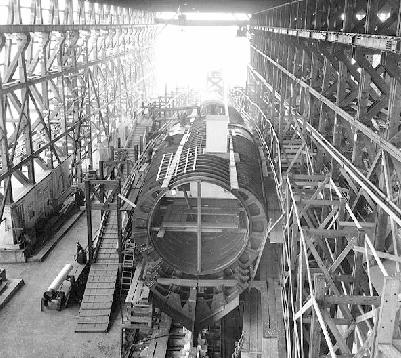
Further along in the construction, another section has been added to Squalus. View is looking aft, early 1938.
National Archives photo.
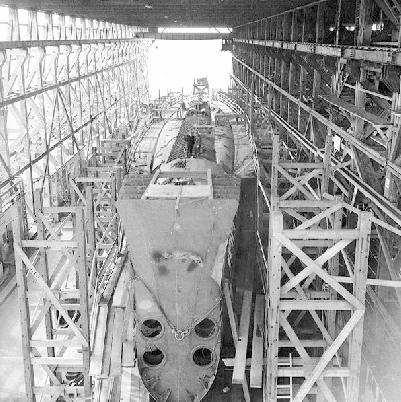
Construction on Squalus has reached the torpedo room area. A much narrower section has been added, and the four holes where the torpedo tubes will be added can be seen. The section above the tube holes is the bow buoyancy tank.
National Archives photo.
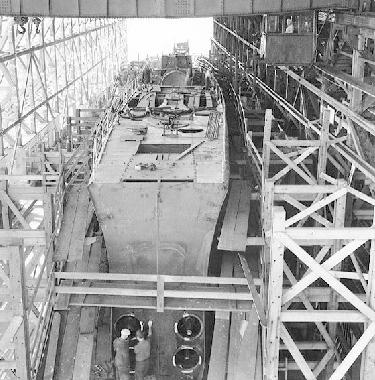
Several weeks later even more progress has been made. More of the superstructure aft of the buoyancy tank has been built out, and the conning tower has been installed amidships along with some of the fairwater support structure. Two yard workers are preparing to install the torpedo tubes.
National Archives photo.
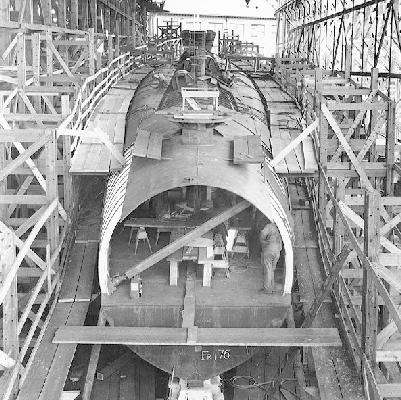
This photo of the Squalus construction is looking forward from the area of the aft torpedo room. Below where the worker is standing is Main Ballast Tank #4. Above on top of the hull is the aft torpedo room access hatch. There is one more section of hull to add to complete the pressure hull buildout. The double hull section of the boat has merged into the pressure hull at this point, so from here aft the boat is of single hull construction. Overall, the boat is considered to be a "partial double hull" design.
Milne Special Collections, University of New Hampshire Library, Durham, N.H.
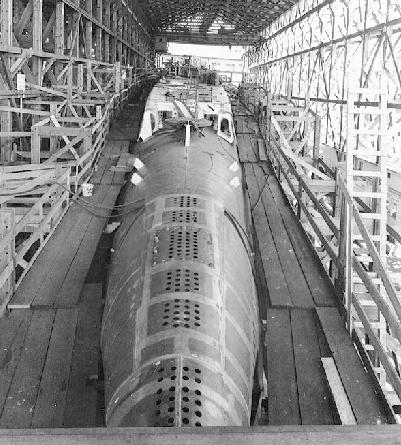
This is the same view as the one above, only after the last section of the hull has been installed, with the four aft torpedo tubes. The aft superstructure has been built out to the aft torpedo room hatch, there is still a little more to go.
National Archives photo.
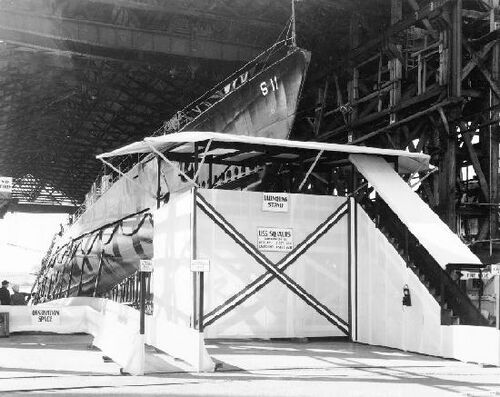
Squalus pre-Launching photo September 14, 1938. The two signs read: "Launching Stand" and "USS Squalus, Submarine (SS-192), Keel Laid Oct. 18, 1937, Launched Sept. 14, 1938"
Milne Special Collections, University of New Hampshire Library, Durham, N.H.
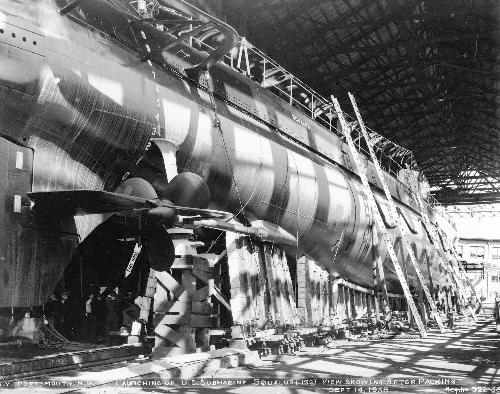
Squalus pre-launching photo, Sept. 14, 1938. View up the starboard side.
Milne Special Collections, University of New Hampshire Library, Durham, N.H.
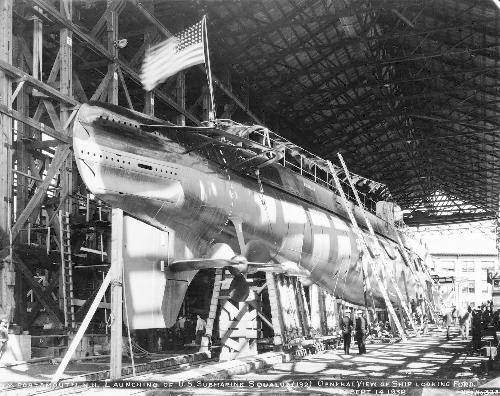
A shot from further back showing the whole stern. Both of the starboard aft torpedo tube shutter doors are visible, as are the rudder, stern diving planes, and propellers.
Milne Special Collections, University of New Hampshire Library, Durham, N.H.
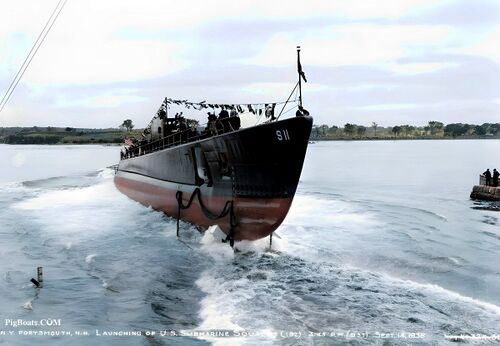
Squalus hitting the water for the first time at 3:45 pm DST on September 14, 1938. Squalus was the last submarine launched with the class identifiers on the hull and fairwater. In early 1939 before she started sea trials, these would be replaced with her hull number, as would all USN fleet submarines.
Milne Special Collections, University of New Hampshire Library, Durham, N.H. Colorization by Ric Hedman.
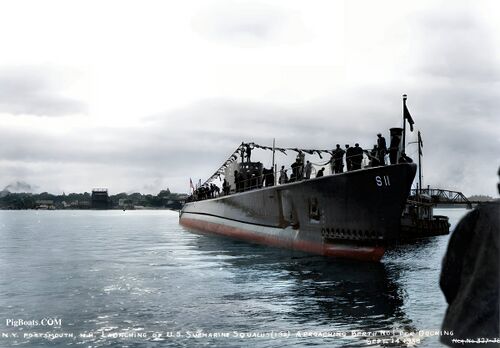
Squalus afloat for the first time and in the process of having tugs push her to the fitting out pier. There was still five and a half months of work left before she would be commissioned.
Milne Special Collections, University of New Hampshire Library, Durham, N.H. Colorization by Ric Hedman.
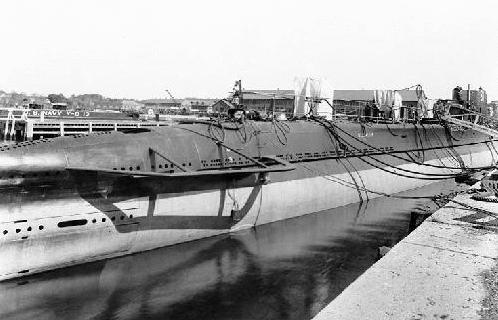
Squalus alongside the fitting out pier at Portsmouth Navy Yard, fall of 1938. The flat metal frame in the foreground is a propeller guard. It prevents a tug boat or a mine cable from fouling on the propeller blades directly below.
National Archives photo.

Another view of Squalus at the Portsmouth fitting out pier, fall of 1938. The work platform erected near her bow is to allow work on the retractable mine cutter arms that are normally hidden inside the superstructure. The boat is still sitting very high in the water in part because her batteries have not yet been installed. The batteries will add several tons of weight to the boat.
Milne Special Collections, University of New Hampshire Library, Durham, N.H. Colorization by Ric Hedman.

A photo of Squalus heading out on sea trials in late April of 1939. She would return to port only once more before her tragic sinking on May 23, 1939. This view is in the Piscataqua River with New Castle Island, New Hampshire in the background.
U.S. Navy photo.
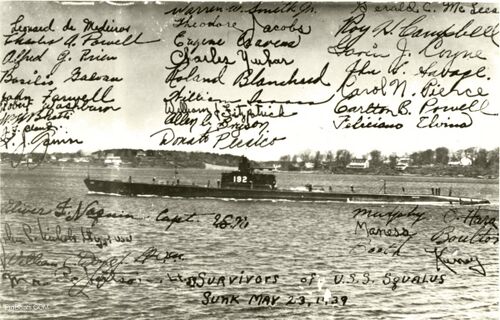
The same photo as above but signed by the survivors of the Squalus' sinking on May 23, 1939. 33 men were rescued but only 32 of them have signed this photo. LT Oliver F. Naquin's signature is just below the bow. He was the Commanding Officer and provided outstanding leadership.
There are three other signatures on this photo that are interesting. In the first column on the left, the third name down the list signed is Alfred G. Prien. He was the man operating the ballast tank vents and main induction that day.
The second name that is significant is that of Allen Carl Bryson. He is the second name from the bottom of the center list. He was the phone talker in control that received the first reports of water flooding into the submarine and reported this to the Captain and officers. The other reason this name is significant is that Carl Bryson became the last surviving member of the rescued crew. He passed on December 1, 2008 at age 91 and is buried in New London, CT.
The third interesting name is that of Gerald Clifton McLees at the top of the right-hand column of names. McLees is believed to have been the second longest surviving crew member, he passed away on December 30, 2004 at age 89.
Photo courtesy of Wendy Gulley of the Submarine Force Library & Museum.
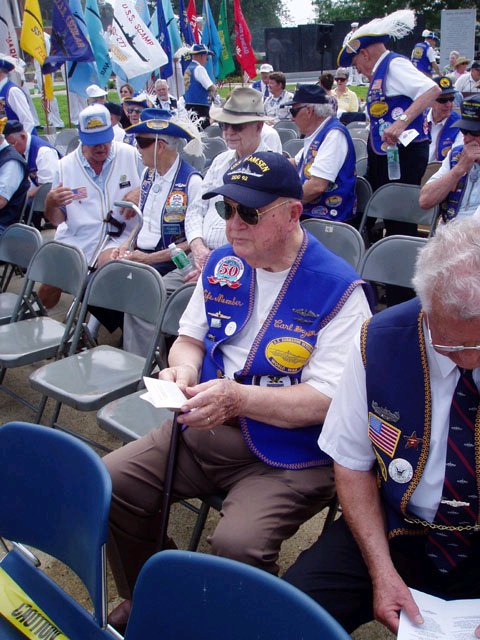
Allen Carl Bryson attending a USSVI gathering in Groton, CT. in 2005. The last surviving member of the Squalus' crew passed away in 2008. Rest easy shipmate, we have the watch.
Photo by Ric Hedman.
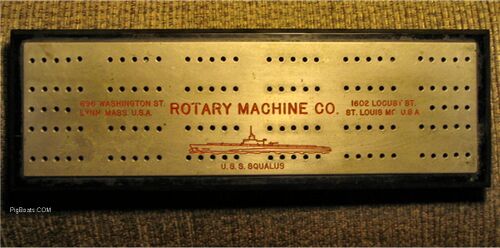
A cribbage board manufactured by what is probably a parts supplier with the USS Squalus name imprinted on it. This was probably one of a number given to ship's company, probably upon commissioning. We can find no information about the Rotary Machine Co., it has no doubt gone out of business or been absorbed into another company.
Photo of the cribbage board in the private collection of Mike Kaup.
Page created by:
Ric Hedman & David Johnston
1999 - 2023 - PigBoats.COM©
Mountlake Terrace, WA, Norfolk, VA
webmaster at pigboats dot com
